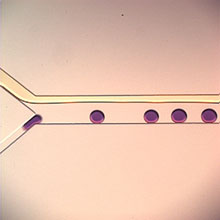Making Cells on an Assembly Line
Researchers have developed a way to create uniformly sized cell membranes, small cellular packages that can be used like tiny terrariums to study the inner workings of the cell and even create new molecules.

Sandro Matosevic and Brian Paegel of the Scripps Research Institute in Jupiter, Florida, have developed a chip-based method that creates uniformly sized vesicles in assembly-line fashion. Sized between 20 and 70 micrometers in diameter, the vesicles are large enough to be loaded with DNA and the biochemical machinery to act as synthetic cells. The synthetic packaging will help researchers study the proteins in cell membranes, which play important roles as gatekeepers of the cell. Many drugs, for example, act on these membrane proteins or otherwise use them to get inside cells in order to do their job.
Paegel and his colleagues want to use the system to create membrane proteins with new and useful functions. “From an evolutionary standpoint, they’re just this really juicy class of molecules to target for new functions, because they do all this interesting chemistry,” Paegel says. These molecules have traditionally been difficult to work with because they require a lipid bilayer—the double layer of fatty molecules that makes up the cell membrane—in order to function. A synthetic cell membrane, like the type created in the study, allows scientists to house a single gene as well as the other biochemical components for synthesizing that membrane protein.
The chip-based approach builds on previous research in which scientists created cell-like membranes in bulk in a centrifuge. In the Scripps team’s microfluidic device, water droplets suspended in oil travel down one branch of a Y-shaped channel. Water flows down the other branch, creating an oil-water interface when the two liquids meet. The device then pushes the droplets through the oil-water interface, where they get coated in another layer of lipids to form the bilayer membrane. The researchers published their work online last month in the Journal of the American Chemical Society.
“The new aspect is the ability to make these giant, cellular-sized liposomal vesicles that are completely uniform in their size and their content. No one’s been able to demonstrate that yet in a robust system,” says Wyatt Vreeland, a research chemical engineer in the biochemical sciences division at the National Institute of Standards and Technology in Gaithersburg, Maryland. “This lets us start to look at reconstituting cellular systems in vitro in a controlled way in order to investigate how different components within a cell work.”
Keep Reading
Most Popular
Large language models can do jaw-dropping things. But nobody knows exactly why.
And that's a problem. Figuring it out is one of the biggest scientific puzzles of our time and a crucial step towards controlling more powerful future models.
The problem with plug-in hybrids? Their drivers.
Plug-in hybrids are often sold as a transition to EVs, but new data from Europe shows we’re still underestimating the emissions they produce.
Google DeepMind’s new generative model makes Super Mario–like games from scratch
Genie learns how to control games by watching hours and hours of video. It could help train next-gen robots too.
How scientists traced a mysterious covid case back to six toilets
When wastewater surveillance turns into a hunt for a single infected individual, the ethics get tricky.
Stay connected
Get the latest updates from
MIT Technology Review
Discover special offers, top stories, upcoming events, and more.